WEB EXTRA~
 John J. Flynn, a University of Utah professor of law for more than four decades, died April 11 in Salt Lake City, one day after his 74th birthday.
John J. Flynn, a University of Utah professor of law for more than four decades, died April 11 in Salt Lake City, one day after his 74th birthday.
John Joseph Flynn was born on April 10, 1936, in Chelmsford, Mass., to George Ryan Flynn and Mary Woodhead Flynn. As a boy in Massachusetts he learned to love music, gardening, and fishing—three passions that remained with him throughout his life. For a while music was something of a career for him: he played sax and clarinet for a number of bands, including that of famed jazzman Maynard Ferguson. He loved fishing for trout and salmon, and his summer garden was always a delight to friends and family. But his true calling was the law, and in his long and storied career he served his country and his community as a teacher, an advocate, a philosopher, and an attorney.
Flynn received a B.S. cum laude from Boston College (1958), an LL.B. from Georgetown University (1961), and an S.J.D. from the University of Michigan (1967). In 1963 he was asked to join the faculty at the University of Utah, and with his beloved wife, Sheila, made Salt Lake City his home. It was from Utah that his profound impact on both the local and the national scene unfurled. As he said so often, “Every legal decision is a moral decision.” His advice and counsel was sought time and again by the administration of the University of Utah throughout his 42-year career there. John was a fierce advocate for faculty governance and a defender of academic freedom. He took great pride in the fact that he was part of the team that drafted the University’s free speech regulations and that they are still in effect. He was honored by the College of Law with the Hugh B. Brown professorship (which he held from 1986 to 2004), and by the U itself in 1987 with the prestigious Rosenblatt Prize for Excellence, the University of Utah’s highest honor, awarded annually at Commencement. Flynn was also one of the United States’ preeminent legal minds in his chosen field of Antitrust. In addition to co-authoring two basic law texts used across the country (Free Enterprise and Economic Organization: Antitrust and Free Enterprise and Economic Regulation: Government Regulation), his counsel was sought by the U.S. Senate and House, Federal and State courts, and the White House. He taught law as a visiting professor at the University of Michigan, Georgetown, Texas, Washington University, and the University of Pennsylvania. He also served as Special Counsel and consultant to the U.S. Senate Judiciary Committee’s Antitrust Subcommittee from 1969 to 1976. He served on the Consumer Advisory Panel to AT&T from 1990 to 1999, as Ombudsman for Utah Power and Light, and was a board member of the Lawyer’s Committee for Civil Rights Under Law. Flynn was particularly proud of two important public service contributions. First was his eight years of service as counsel to the legendary Sen. Phil Hart (D-Mich.), chair of the Antitrust Subcommittee of the Senate Judiciary Committee. Second was his central role in obtaining divestiture of the Northwest Pipeline system from El Paso Natural Gas by the United States Supreme Court.
John Flynn is survived by his wife of nearly 50 years, Sheila; children and daughters-in-law John J. Flynn Jr. and Risa Palley Flynn of Culver City, Calif., Siobhan M. Flynn of Berkeley, Calif., and Timothy R. Flynn and Terry Ellis of Royal Oaks, Calif.; and four grandchildren, Shea Shannon McFarlin Flynn, John Ephraim Palley Flynn, Max Edward Palley Flynn, and Tadg Rowan Ellis Flynn; siblings Rev. George Flynn of Lima, Peru; Patrick Flynn and wife Elizabeth of Phoenix; Joseph Flynn of Boston; and Ann Flynn of Worcester, Mass. He was predeceased by his parents and siblings Jude T. Flynn and Mary Flynn. A grand celebration of John’s life and work will be held later in the year in Salt Lake City, and information about that event as well as comments and memories from the public can be found at a special memorial site at www.johnflynnmemorial.org. In lieu of flowers, the family suggests that donations be made in the name of John Joseph Flynn to the Myelodysplastic Syndromes (MDS) Foundation, the Huntsman Cancer Center, or And Justice For All.
Edited from the notice published in The Salt Lake Tribune on 4/14/2010.
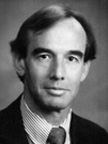 Kevin J. Gully BS’75, Ph.D., ABPP, a Utah forensic psychologist whose career revolved around helping those recovering from traumatic experiences, died February 16. He was 58.
Kevin J. Gully BS’75, Ph.D., ABPP, a Utah forensic psychologist whose career revolved around helping those recovering from traumatic experiences, died February 16. He was 58.
Kevin Jungers Gully was born Dec. 17, 1951, in Salt Lake City, the fifth child of Walter James Gully and Helen Harriet Mondloch. He was student body president and played football for Judge Memorial High School. He did his undergraduate work at the University of Utah, pursued his master’s degree in psychology at UTEP, and received his doctorate in clinical psychology at Washington State University. He became an associate professor at the University of Utah and dedicated his life to helping traumatized adults and children as a forensic psychologist for the Safe and Healthy Families program at Primary Children’s Medical Center. He evaluated and treated abused adults and children, including those who were homeless and in custody of adult and juvenile corrections. He was known for his expertise, professionalism, breadth of knowledge, and enthusiasm, and was sought after as a presenter, mentor, researcher, and teacher.
A diplomate in forensic pychology with the American Board of Professional Psychology (ABPP), he developed two important psychological evaluation tests, the “Social Behavior Inventory” and the “Expectations Test.” He also made significant contributions to Utah’s judicial system and in 2007, received the annual Amicus Curiae Award, presented by the Chief Justice of the Utah Supreme Court for outstanding contributions to the improvement of the Utah judicial system. He was appointed by Gov. Jon Huntsman to the board of the State Division of Child and Family Services, and the Chief Justice appointed him to the Guardian ad Litem Oversight Committee.
At the U, Kevin was a member of the Sigma Chi fraternity, a tradition his two sons followed. His passions were skiing, hiking, and spending time with his family, especially at the cabin. He loved team sports, playing card games, and was also a member of the Wasatch Mountain Club. Kevin’s sense of humor was cherished by his family and friends.
Kevin is survived by Pamella Spence Gully, his wife of 34 years; sons Adam and Eric; sister Nana Penrose; twin brothers Monty and William (Tina); sister-in-law Janice; and numerous nieces and nephews. He was preceded in death by his parents and his brother James. In lieu of flowers, family suggests donations to Primary Children’s Medical Center, Center for Safe and Healthy Families.
Edited from the notice published in the Deseret News from 2/21-2/23/10.
 Walter J. Hawkins BS’73, a former Ute basketball player and coach, died peacefully at home in Arlington, Va., on November 28, 2009. He was 62.
Walter J. Hawkins BS’73, a former Ute basketball player and coach, died peacefully at home in Arlington, Va., on November 28, 2009. He was 62.
Walter Jerome Hawkins was born April 25, 1947, to Bishop Robert L. and Josephine Hawkins. Walter joined the church at an early age and enjoyed singing in the choir with his brothers as they accompanied their father in his ministry. An athlete, as a youth he participated in many different sports. Walter attended Luther Jackson High School, where he played both football and basketball, and later W.T.Woodson High School, where he became an outstanding basketball player and received a place in the school’s Hall of Fame. Following his graduation from Woodson in 1966, he attended Neosho College in Kansas, where he was named an All-American Basketball Player and received an associate degree. In 1968, he was selected as an alternate for the U.S. Olympic basketball team and played in the National Invitational Tournament at Madison Square Garden. He later continued his education at the University of Utah, where he served as captain of the basketball team and later as assistant coach for the team.
Beginning in 1976, Walter served for 27 years as an integral part of the growth of his longtime dream, a facility providing recreation and civic activities in the Bailey’s Crossroads area of Arlington. He became the Bailey’s Community Center director and also worked as a recreation specialist at the Social Center for Psychological Rehabilitation from 1980 until 1992. He retired in 1992. Walter also had a love for horticulture and spent time cultivating his yard to make it a sight of beauty in the community. After retirement, he formed Hawk-Eye Landscaping Services to help make any yard or flower garden beautiful.
Walter is survived by his wife of 39 years, Pamela Hawkins; children Katherine (Romayn) Robinson, Robert, Randolph (Vannora), Tuscon (Zeineba) Hawkins, and Walter Winston; siblings Celeste Morton, Constance Moore, Alice Hawkins, Jacqueline Hawkins-White, James, Albert, Steven, Michael and Conrad Hawkins; five grandchildren; and numerous other family members. He was preceded in death by his parents and his brother Carl. Interment is at Pleasant Valley Memorial Park.
Edited from the notice published in the Washington Post on 12/2/09 and other sources provided by the family.
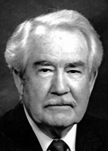 Paul Hodson BA’36, former U of U business vice president and vice president of special projects and international relations, died March 24. He was 100.
Paul Hodson BA’36, former U of U business vice president and vice president of special projects and international relations, died March 24. He was 100.
Paul William Hodson was born in the family home on Brigham Street (East South Temple Street) in Salt Lake City on May 8, 1909, to John Thomas Hodson and Coralee Alvira Smith. Paul served as a missionary in the LDS German-Austrian Mission from 1930 to 1933 where he witnessed the rise to power of Adolf Hitler, which greatly impacted his future. Upon his return, he attended and graduated from the University of Utah. The following summer, he visited his mentor and employer Wallace F. Bennett at Bennett Paint Company and asked to marry his secretary and borrow $1,000 to attend Harvard. He and Shelley Holmes were married September 7, 1937, and immediately left for Springfield, Mass., where he received his MBA. He continued on to doctoral studies at Stanford University. During World War II, he served on the University of Utah faculty and in the administration of the wartime campus and its soldier-training mission. In the final period of the war, he was assigned by the War Department to the European Theater of Operations as chief of the Austrian team, Morale Division, of the United States Strategic Bombing Survey.
Hodson was the business vice president at the University of Utah during its postwar expansion in the 1950s and 1960s when the campus was redesigned and 30 major buildings and an equal number of minor buildings were funded and built. He then became the U’s vice president of special projects and international relations. He filled U.S. State Department and other foreign consulting assignments in Venezuela, Mexico, Bolivia, Spain, Germany, and England, and chaired the U’s faculty committee on international relations. The University’s Board of Trustees gave him the title of vice president emeritus upon his retirement in 1973.
Active in professional and civic affairs, Hodson served as president of the Western Association of College and University Business Officers, and on the governing boards of several other organizations, including the National Association of College and University Business Officers, the Salt Lake Rotary Club, and Blue Cross of Utah. The U of U Alumni Association in 1974 presented him with the Distinguished Alumnus Award. He was an active member of the Professors Emeriti Club, University of Utah; and the Monday Nighters, a conversation club from the University community.
Following retirement from the University, Hodson developed a horse-oriented planned unit community in Sandy called the Dimple Dell Ranchettes. As chair of Salt Lake County’s citizens’ advisory committee, he was active in the establishment of the 624-acre Dimple Dell Regional Park. His retirement activities included the writing and publishing of several books: Crisis on Campus: The exciting years of campus development at the University of Utah; Never Forsake: The Story of Amanda Barnes Smith, Legacy of the Haun’s Mill Massacre; My Several Lives: An Autobiography; and Insights Gained from Events Remembered.
An active member of The Church of Jesus Christ of Latter-day Saints and devoted father, Paul always insisted that his greatest achievement was in marrying Shelley and, with her, raising a wonderful family of eight children, 29 grandchildren, 38 great-grandchildren, and one great-great-grandchild. Survivors include children Susan Gunnarson (Lynn), Jeannie Kathleen Jones, Paul William “Bill” Hodson, Jr., Steven Holmes Hodson (Colleen), Jonathan Holmes Hodson (Cherie), Elizabeth Ann Hodson, and Robert Holmes Hodson (Marianne). He was preceded in death by his wife, Shelley; his son David Holmes Hodson; granddaughter Debbie Nemelka Spotts; and grandson Jon Nemelka.
Edited from the notice published in The Salt Lake Tribune from 3/26-3/28/2010.
 William R. Slager PhD’51, a longtime University of Utah professor of English and Linguistics, died March 11. He was 84.
William R. Slager PhD’51, a longtime University of Utah professor of English and Linguistics, died March 11. He was 84.
William Russell Slager was born November 8, 1925, in Butte, Montana. He attended the University of Minnesota, where he was a lieutenant in the U.S. Navy and received a bachelor’s degree in Naval Science and Tactics. He then came to the University of Utah to begin the pursuit of his life’s work, teaching language. After receiving his doctorate, was faculty member at the University of Utah, where he was a full professor of English and Linguistics. In 1969, he founded the Linguistics Program and served as its director for six years. He was also chair of the Department of English from 1975 to 1978. Bill served two Fulbright assignments in Egypt (1952-54 and 1958-59), a State Department Cultural Exchange assignment to Guadalajara, Mexico (1967-68), and an assignment as a visiting professor at Zhejiang University in Hangzhou, China (1982). He also taught summer sessions at Michigan State University, the University of Michigan, and UCLA. He served on major national committees including the National Advisory Council on the Teaching of English as a Second Language, Council of International Exchange of Scholars, the Committee of Examiners for TOEFL (Test of English as a Foreign Language), and Educational Testing Service. His service to professional organizations included chair, Association of Teachers of English as a Second Language, and director, National Council of Teachers of English. In the1960s and 70s, Bill consulted extensively for the Center for Applied Linguistics (especially on bilingual programs for Native Americans, including Navajo, Papago, Crow, and Lakota); for the National Council of Teachers of English, the U.S. Office of Education, and the Field Service of the National Association of Foreign Student Affairs. He lectured and gave workshops throughout the world including in Syria, Italy, Spain, Fiji, India, Poland, Brazil, Columbia, Morocco, and Tunisia. He also served as an Academic Specialist for the United States Information Agency in Czechoslovakia, Pakistan, Italy, the USSR, Mexico, Paraguay, and Kuwait. His major publications include articles and textbooks; most notably he was chief author and project director for the National Council of Teachers of English on English for Today, the first textbook series in English as a second language to be published by an American author and publisher (McGraw-Hill).
Bill Slager is survived by his best friend and ex-wife, Athena Slager; his three children and their spouses, Christopher Slager, Jonathan Slager (daughter-in-law Liz Slager), and Tina Bland (son-in-law Jeff Bland); and six grandchildren, Christopher Slager, Samantha Slager, Kassandra Metos, Nicholas Metos, Melissa Metos, and Athena Bland. Bill requested no funeral or services to be held on his behalf, but was willing to accommodate his family by allowing a party to be held in his honor.
Edited from the notice published in The Salt Lake Tribune from 3/13-3/14/2010.
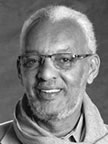 Teshome H. Gabriel BA’67 MEd’69, an internationally recognized scholar of Third World cinema, died June 14 of sudden cardiac arrest. He was 70.
Teshome H. Gabriel BA’67 MEd’69, an internationally recognized scholar of Third World cinema, died June 14 of sudden cardiac arrest. He was 70. Peter Heilbrun, a leading brain surgeon and former chair of the University of Utah’s Department of Neurosurgery, died at home in Sausalito, Calif., on Sept. 27 surrounded by his family. He was 73.
Peter Heilbrun, a leading brain surgeon and former chair of the University of Utah’s Department of Neurosurgery, died at home in Sausalito, Calif., on Sept. 27 surrounded by his family. He was 73. Matthew Simmons BS’65, founder of one of the earliest investment banking boutiques focused on the energy sector and a major proponent of the idea of “peak oil,” died unexpectedly on August 8. He was 67.
Matthew Simmons BS’65, founder of one of the earliest investment banking boutiques focused on the energy sector and a major proponent of the idea of “peak oil,” died unexpectedly on August 8. He was 67. Christopher R. Johnson MS’84 PhD’90, Distinguished Professor of computer science, was honored at last May’s Commencement with the Rosenblatt Prize for Excellence, the U’s most prestigious award. The $40,000 gift is presented annually to a faculty member who displays excellence in teaching, research, and administrative efforts. As director of the Scientific Computing and Imaging (SCI) Institute, Johnson oversees cutting-edge research in the areas of scientific computing, visualization, and image analysis. He sat down recently with Continuum to share his thoughts on winning the Rosenblatt Prize.
Christopher R. Johnson MS’84 PhD’90, Distinguished Professor of computer science, was honored at last May’s Commencement with the Rosenblatt Prize for Excellence, the U’s most prestigious award. The $40,000 gift is presented annually to a faculty member who displays excellence in teaching, research, and administrative efforts. As director of the Scientific Computing and Imaging (SCI) Institute, Johnson oversees cutting-edge research in the areas of scientific computing, visualization, and image analysis. He sat down recently with Continuum to share his thoughts on winning the Rosenblatt Prize. Want to know the latest Utah athletics scores? Looking for detailed information on upcoming campus events? Or, just want to see the latest photos and videos from the U, all while on the go? Well, there’s an app for that! The University of Utah has developed an iPhone and iPod Touch application that is now available at the Apple “app store.” Campus news, maps, directories, weather, multimedia, events, helpful links, and sports info can now be found with the flick of a finger. The app even includes an audio track of “Utah Man”—just search the app store for “University of Utah” and share your crimson pride straight from your phone.
Want to know the latest Utah athletics scores? Looking for detailed information on upcoming campus events? Or, just want to see the latest photos and videos from the U, all while on the go? Well, there’s an app for that! The University of Utah has developed an iPhone and iPod Touch application that is now available at the Apple “app store.” Campus news, maps, directories, weather, multimedia, events, helpful links, and sports info can now be found with the flick of a finger. The app even includes an audio track of “Utah Man”—just search the app store for “University of Utah” and share your crimson pride straight from your phone.



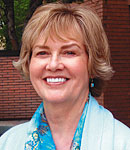 Sheryl Allen BS’65 MEd’90 is well-known in Utah, having served in the State House of Representatives since 1994 and because she is currently running for office as lieutenant governor beside Salt Lake County Mayor Peter Corroon. Over the years she has been involved in numerous educational projects in the Davis County School District, where she is currently the district’s special projects director. She has been a member of several working boards, both at the University of Utah and in the local community, and has been recognized with a variety of community awards, including the National Legislator of the Year Award from Americans for the Arts and the Utah Arts Council Governor’s Recognition for Achievement, among many others. Sheryl is married to John C. Allen BS’64, who played on the U of U basketball team in 1962-1963. Sheryl notes that three of their four children, as well as her parents, all graduated from the U. “My blood proudly runs crimson red,” she says.
Sheryl Allen BS’65 MEd’90 is well-known in Utah, having served in the State House of Representatives since 1994 and because she is currently running for office as lieutenant governor beside Salt Lake County Mayor Peter Corroon. Over the years she has been involved in numerous educational projects in the Davis County School District, where she is currently the district’s special projects director. She has been a member of several working boards, both at the University of Utah and in the local community, and has been recognized with a variety of community awards, including the National Legislator of the Year Award from Americans for the Arts and the Utah Arts Council Governor’s Recognition for Achievement, among many others. Sheryl is married to John C. Allen BS’64, who played on the U of U basketball team in 1962-1963. Sheryl notes that three of their four children, as well as her parents, all graduated from the U. “My blood proudly runs crimson red,” she says. Geoffrey H. Lee ex’86 is vice president, affiliate relations, at vehix.com. Geoff has more than 15 years of sales and marketing experience in advertising and professional services. He served as advertising director for Skiing Utah magazine from 1986 to 1988, when he joined American Lawyer Media in Dallas, Texas. AmLaw is the world’s foremost legal media giant, whose myriad holdings included Court TV and American Lawyer Magazine. In less than two years, Geoff was responsible for doubling advertising revenue for AmLaw’s Texas region. In 1990 he joined Fox-Morris, a large national recruiting firm, to establish the company’s legal search division. He consistently ranked among the company’s top producers nationally. Geoff founded Counsel Source, Inc., a full-service attorney search firm, in 1995. In a few short years, he built the company into a multimillion-dollar business. Geoff is married to Diane M. Krogh Lee ex’89.
Geoffrey H. Lee ex’86 is vice president, affiliate relations, at vehix.com. Geoff has more than 15 years of sales and marketing experience in advertising and professional services. He served as advertising director for Skiing Utah magazine from 1986 to 1988, when he joined American Lawyer Media in Dallas, Texas. AmLaw is the world’s foremost legal media giant, whose myriad holdings included Court TV and American Lawyer Magazine. In less than two years, Geoff was responsible for doubling advertising revenue for AmLaw’s Texas region. In 1990 he joined Fox-Morris, a large national recruiting firm, to establish the company’s legal search division. He consistently ranked among the company’s top producers nationally. Geoff founded Counsel Source, Inc., a full-service attorney search firm, in 1995. In a few short years, he built the company into a multimillion-dollar business. Geoff is married to Diane M. Krogh Lee ex’89. Keith Wallace BS’72 is senior vice president and CFO with trucking company C.R. England, Inc. While a student at the U, Keith became a member of the Sigma Chi fraternity and joined the Utah National Guard, serving as a captain from 1970-77. A certified public accountant and certified financial planner (as well as a licensed real estate broker in Utah with experience in real estate development), Keith joined C. R. England in 1993. Since leaving the U, he has been involved with the David Eccles School of Business Alumni Board and the national advisory council for the business school’s Pierre Lassonde Entrepreneur Center. He has also served as a member of the U.S. Bank board of advisors. Keith has helped grow C.R. England into a $1 billion business encompassing more than 35 different operating units. Utah Business magazine recognized Keith in 2010 as one of its CFOs of the Year. Keith is married to the former Carol Callister BS’70.
Keith Wallace BS’72 is senior vice president and CFO with trucking company C.R. England, Inc. While a student at the U, Keith became a member of the Sigma Chi fraternity and joined the Utah National Guard, serving as a captain from 1970-77. A certified public accountant and certified financial planner (as well as a licensed real estate broker in Utah with experience in real estate development), Keith joined C. R. England in 1993. Since leaving the U, he has been involved with the David Eccles School of Business Alumni Board and the national advisory council for the business school’s Pierre Lassonde Entrepreneur Center. He has also served as a member of the U.S. Bank board of advisors. Keith has helped grow C.R. England into a $1 billion business encompassing more than 35 different operating units. Utah Business magazine recognized Keith in 2010 as one of its CFOs of the Year. Keith is married to the former Carol Callister BS’70. John Youngren BA’88 is vice president, strategic communications, with the full-service ad agency Love Communications, serving as both head of the agency’s public relations team and its senior account supervisor. John has long juggled multiple roles. As a student, he began working in advertising with Harris & Love and spent a year as editor-in-chief at The Daily Utah Chronicle. He joined the Ogden Standard-Examiner, where he was a sportswriter and columnist (1988-95), and served as corporate communications manager with Regence BlueCross BlueShield (1990-95). He then spent a year as creative services director for a cable media company before rejoining Harris & Love as vice president and group account director (1996-2001). In the mid-late 1990s, he also spent several years as a television columnist for The Salt Lake Tribune and the Standard-Examiner. John has been widely involved with the U since his graduation, serving the Beehive Honor Society Board (1992-95), the Young Alumni Board (1996-2000), and the Publications Council (1995-97 and 2006-08). He is also a regular contributor to this magazine.
John Youngren BA’88 is vice president, strategic communications, with the full-service ad agency Love Communications, serving as both head of the agency’s public relations team and its senior account supervisor. John has long juggled multiple roles. As a student, he began working in advertising with Harris & Love and spent a year as editor-in-chief at The Daily Utah Chronicle. He joined the Ogden Standard-Examiner, where he was a sportswriter and columnist (1988-95), and served as corporate communications manager with Regence BlueCross BlueShield (1990-95). He then spent a year as creative services director for a cable media company before rejoining Harris & Love as vice president and group account director (1996-2001). In the mid-late 1990s, he also spent several years as a television columnist for The Salt Lake Tribune and the Standard-Examiner. John has been widely involved with the U since his graduation, serving the Beehive Honor Society Board (1992-95), the Young Alumni Board (1996-2000), and the Publications Council (1995-97 and 2006-08). He is also a regular contributor to this magazine.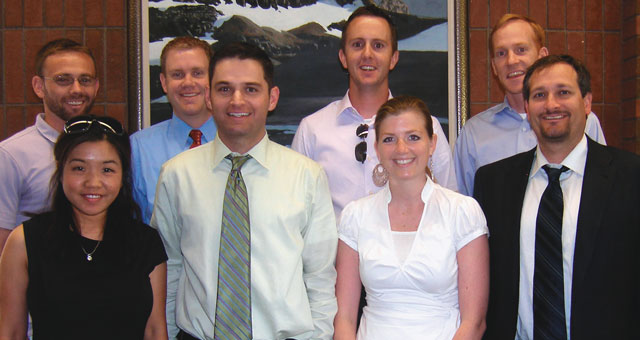
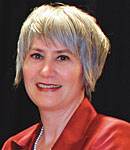 Michele Mattsson HBA’85 JD’88, currently serving the last year of a three-year term as president of the University of Utah Alumni Association (UUAA), was highlighted last spring in Utah Business magazine (April 2010) as one of “Thirty Women To Watch”—meaning those women who, in striving for professional excellence, are helping shape and move forward Utah’s business community.
Michele Mattsson HBA’85 JD’88, currently serving the last year of a three-year term as president of the University of Utah Alumni Association (UUAA), was highlighted last spring in Utah Business magazine (April 2010) as one of “Thirty Women To Watch”—meaning those women who, in striving for professional excellence, are helping shape and move forward Utah’s business community.


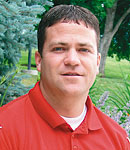 With his extensive record of involvement with the University of Utah over the past few years, Kevin Stoker BS’06 MBA’09 is a perfect fit as the Alumni Association’s new advancement coordinator. In this role, he heads up a multitude of regional and alumni chapter initiatives across the country, including the launch of a new Boise, Idaho, chapter this past summer (see opposite page for details).
With his extensive record of involvement with the University of Utah over the past few years, Kevin Stoker BS’06 MBA’09 is a perfect fit as the Alumni Association’s new advancement coordinator. In this role, he heads up a multitude of regional and alumni chapter initiatives across the country, including the launch of a new Boise, Idaho, chapter this past summer (see opposite page for details). The 2010 legislative session proved difficult for higher education—but it could’ve been worse.
The 2010 legislative session proved difficult for higher education—but it could’ve been worse.
 What To Do at the U during the Summer
What To Do at the U during the Summer







 The Digit
The Digit John J. Flynn, a University of Utah professor of law for more than four decades, died April 11 in Salt Lake City, one day after his 74th birthday.
John J. Flynn, a University of Utah professor of law for more than four decades, died April 11 in Salt Lake City, one day after his 74th birthday. Kevin J. Gully BS’75, Ph.D., ABPP, a Utah forensic psychologist whose career revolved around helping those recovering from traumatic experiences, died February 16. He was 58.
Kevin J. Gully BS’75, Ph.D., ABPP, a Utah forensic psychologist whose career revolved around helping those recovering from traumatic experiences, died February 16. He was 58. Walter J. Hawkins BS’73, a former Ute basketball player and coach, died peacefully at home in Arlington, Va., on November 28, 2009. He was 62.
Walter J. Hawkins BS’73, a former Ute basketball player and coach, died peacefully at home in Arlington, Va., on November 28, 2009. He was 62. Paul Hodson BA’36, former U of U business vice president and vice president of special projects and international relations, died March 24. He was 100.
Paul Hodson BA’36, former U of U business vice president and vice president of special projects and international relations, died March 24. He was 100. William R. Slager PhD’51, a longtime University of Utah professor of English and Linguistics, died March 11. He was 84.
William R. Slager PhD’51, a longtime University of Utah professor of English and Linguistics, died March 11. He was 84.



 With an eye on the increasing cost of tuition, the Alumni Association has allocated more than $250,000 in student scholarships for 2010-2011. Scholarship funds come from individual donations, the Association’s affinity partner relationships (U of U credit card, insurance, and other programs), the Scholarship Walkway, U of U license plate fees, and the Homecoming 5K Run and Scholarship Golf Scramble.
With an eye on the increasing cost of tuition, the Alumni Association has allocated more than $250,000 in student scholarships for 2010-2011. Scholarship funds come from individual donations, the Association’s affinity partner relationships (U of U credit card, insurance, and other programs), the Scholarship Walkway, U of U license plate fees, and the Homecoming 5K Run and Scholarship Golf Scramble.

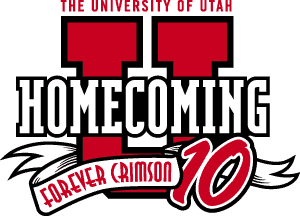




 The Utah Museum of Natural History at the University of Utah assumed full management responsibilities for the historic Wilcox Ranch in Range Creek Canyon on December 17, 2009. Known for its remote and rugged landscape, Range Creek, located about 30 miles southeast of Price, Utah, has become valued by researchers from across the country for its unique prehistoric Fremont archeological sites. The Utah Division of Wildlife Resources (DWR), the Utah School and Institutional Trust Lands Administration (SITLA), and the UMNH participated in a three-way land transfer in order for the museum to lease the Wilcox Ranch for use as a field research station. DWR had been appointed the responsible agency in 2004. For the past 10 years, museum and U of U archeologists and staff have helped to direct the scientific research of Range Creek, focusing on archeology, botany, and geography.
The Utah Museum of Natural History at the University of Utah assumed full management responsibilities for the historic Wilcox Ranch in Range Creek Canyon on December 17, 2009. Known for its remote and rugged landscape, Range Creek, located about 30 miles southeast of Price, Utah, has become valued by researchers from across the country for its unique prehistoric Fremont archeological sites. The Utah Division of Wildlife Resources (DWR), the Utah School and Institutional Trust Lands Administration (SITLA), and the UMNH participated in a three-way land transfer in order for the museum to lease the Wilcox Ranch for use as a field research station. DWR had been appointed the responsible agency in 2004. For the past 10 years, museum and U of U archeologists and staff have helped to direct the scientific research of Range Creek, focusing on archeology, botany, and geography. Contrary to what some might believe, living near a variety of restaurants, convenience stores, supermarkets, and even fast food outlets actually lowers one’s risk for obesity, according to a new study from the U. Surprisingly, people who live more than a half-mile away from any food outlets are the ones who tend to be fatter. “Having access to a range of food options in your neighborhood affects both your energy input and output,” says Cathleen Zick, coauthor of the study and professor of family and consumer studies. “A healthy grocery option may influence the food you choose to buy, while having multiple food destinations within walking distance might encourage you to walk, rather than drive, to your next meal.” The study suggests that placing restrictions on fast food outlets may not be effective, but that initiatives to increase healthy neighborhood food options may reduce individuals’ obesity risks, especially if focused on low-income neighborhoods.
Contrary to what some might believe, living near a variety of restaurants, convenience stores, supermarkets, and even fast food outlets actually lowers one’s risk for obesity, according to a new study from the U. Surprisingly, people who live more than a half-mile away from any food outlets are the ones who tend to be fatter. “Having access to a range of food options in your neighborhood affects both your energy input and output,” says Cathleen Zick, coauthor of the study and professor of family and consumer studies. “A healthy grocery option may influence the food you choose to buy, while having multiple food destinations within walking distance might encourage you to walk, rather than drive, to your next meal.” The study suggests that placing restrictions on fast food outlets may not be effective, but that initiatives to increase healthy neighborhood food options may reduce individuals’ obesity risks, especially if focused on low-income neighborhoods. How do fruit flies get high cholesterol and become obese? The same way people do: by eating a diet that’s too rich in fats. But more important, according to two new studies led by Carl S. Thummel, professor of human genetics at the U of U School of Medicine, fruit flies use the same molecular mechanisms as humans to help maintain the proper balance of cholesterol and a key form of stored fat that contributes to obesity. The findings mean that as researchers try to learn more about the genetic and biological processes through which people regulate cholesterol and fat metabolism, the humble fruit fly, genus Drosophila, can teach humans much about themselves. “Not a lot is known about these regulatory mechanisms in people,” says Thummel. “But we can learn a lot by studying metabolic control in fruit flies and apply what we learn to humans.” High cholesterol and obesity, which affects an estimated 25 to 30 percent of the U.S. population, are linked to heart disease, diabetes, and other maladies that take huge tolls on human health and add billions of dollars to the nation’s medical bills. Understanding the processes that regulate cholesterol and fat in humans could be critical for addressing those health risks in people, Thummel believes.
How do fruit flies get high cholesterol and become obese? The same way people do: by eating a diet that’s too rich in fats. But more important, according to two new studies led by Carl S. Thummel, professor of human genetics at the U of U School of Medicine, fruit flies use the same molecular mechanisms as humans to help maintain the proper balance of cholesterol and a key form of stored fat that contributes to obesity. The findings mean that as researchers try to learn more about the genetic and biological processes through which people regulate cholesterol and fat metabolism, the humble fruit fly, genus Drosophila, can teach humans much about themselves. “Not a lot is known about these regulatory mechanisms in people,” says Thummel. “But we can learn a lot by studying metabolic control in fruit flies and apply what we learn to humans.” High cholesterol and obesity, which affects an estimated 25 to 30 percent of the U.S. population, are linked to heart disease, diabetes, and other maladies that take huge tolls on human health and add billions of dollars to the nation’s medical bills. Understanding the processes that regulate cholesterol and fat in humans could be critical for addressing those health risks in people, Thummel believes.